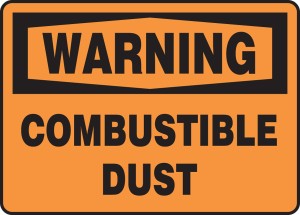 With the NFPA publishing the NFPA 652 Standard on Fundamentals of Combustible Dust the new OSHA combustible dust standard can now move closer to becoming adopted. It is important to take a moment to look over what this standard with cover and take the necessary steps to prepare for it ahead of time. While OSHA’s regulations for combustible dust have seemed to be on hold, there is now a Small Business Regulatory Enforcement Fairness Act (SBREFA) panel scheduled for later this year to specifically review how this new standard will affect small businesses.
With the NFPA publishing the NFPA 652 Standard on Fundamentals of Combustible Dust the new OSHA combustible dust standard can now move closer to becoming adopted. It is important to take a moment to look over what this standard with cover and take the necessary steps to prepare for it ahead of time. While OSHA’s regulations for combustible dust have seemed to be on hold, there is now a Small Business Regulatory Enforcement Fairness Act (SBREFA) panel scheduled for later this year to specifically review how this new standard will affect small businesses.
What standards does OSHA currently use to enforce combustible dust regulations?
General Industry (29 CFR 1910)
o 1910 Subpart D, Walking-working surfaces
o 1910.22, Housekeeping
o 1910 Subpart E, Exit routes, emergency action plans, and fire prevention plans
o 1910.38, Emergency action plans
o 1910 Subpart G, Occupational health and environmental control
o 1910.94, Ventilation
o 1910 Subpart J, General environmental controls
o 1910.146, Permit-required confined spaces
o 1910 Subpart L, Fire protection
o 1910.157, Portable fire extinguishers
o 1910.165, Employee alarm systems
o 1910 Subpart N, Materials handling and storage
o 1910.176, Handling materials – general
o 1910.178, Powered industrial trucks
o 1910 Subpart R, Special industries
o 1910.261, Pulp, paper, and paperboard mills
o 1910.263, Bakery equipment
o 1910.265, Sawmills
o 1910.269, Electric power generation, transmission, and distribution
o 1910.272, Grain handling facilities
o 1910 Subpart S, Electrical
o 1910.307, Hazardous (classified) locations
o 1910 Subpart Z, Toxic and hazardous substances
o 1910.1200, Hazard communication
General Duty Clause
If a hazard is not addressed by an OSHA standard, Section 5(a)(1) of the OSH Act, often referred to as the General Duty Clause, may apply. This section requires employers to “furnish to each of his employees employment and a place of employment which are free from recognized hazards that are causing or are likely to cause death or serious physical harm to his employees”.
These various OSHA standards are all based off different NFPA standards. The NFPA 654 and the following OSHA Combustible Dust regulations were created to streamline the process and unify all the requirements in one place. Luckily this means that if you were in compliance with the previous applicable standards you’ll most likely still be in compliance with the new standards and regulations.
The main aspect that is changing is that businesses will now be required to retroactively have a dust hazard analysis performed on all operations that produce, process, handle or store dusts. Also specified is that the facility owner or operator will be held responsible for determining if the materials being handled in operations are combustible, and determining their properties for the dust hazard assessment.
Need help getting your facility up to the new combustible dust regulations? Contact us now to find out how we can help.
888-845-3952 or Contact Us
Hughes Environmental technicians are expertly trained in the best methods for cleaning combustible dust hazards and use equipment specifically designed for combustible dust cleaning.
Hughes Environmental is a National Air Duct Cleaner’s Association (NADCA) certified company who has earned their prestigious “Outstanding Safety Award” every year that we’ve been in business.
Our technicians are trained on the most up-to-date industry standards for cleaning commercial HVAC systems, and are equipped to clean from the point the air enters the system all the way to where it exits.

